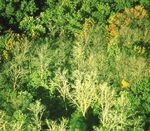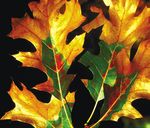Oak Wilt - USDA Forest Service
←
→
Page content transcription
If your browser does not render page correctly, please read the page content below
Oak Wilt
Red oaks die quickly; white oaks may recover
Pathogen—Oak wilt is caused by the fungus Ceratocystis fagacearum. This disease occurs in Kansas, Nebraska,
and South Dakota.
Vectors—Beetles in the Nitidulidae family and oak bark beetles (Pseudopityophthorus spp.) can transmit the
fungus.
Hosts—Oak wilt is a disease of oak species. Species in the red oak group die more quickly than species in the
white oak group.
Signs and Symptoms—The only
visible signs are the black and gray
fungal mats (fig. 1) that are common
in infected red oaks but less common
or less apparent in white oaks. The
mats form beneath the bark soon after
mortality. These mats occasionally
raise and crack the bark (fig. 2). Other
signs of the pathogen are microscopic.
Laboratory tests and fungal culturing
on agar media can be used to confirm
the pathogen’s presence.
For the red oak group, symptoms are
often expressed in spring but can con-
tinue into the summer. Symptoms start
from the tip and outer edges of leaves
and move toward the midrib and base Figure 1. Fungal mat of oak wilt Figure 2. Cracked bark caused by fungal mat of
disease. Photo: Fred Baker, Utah State oak wilt disease. Photo: Joseph O’Brien, USDA Forest
of leaves, often with a distinct margin
University, Bugwood.org. Service, Bugwood.org.
(fig. 3). First, leaves turn dull green
or bronze, can appear water-soaked,
and wilt. Later, the leaves turn yellow
and/or brown, curl around the midrib,
and are shed at branch tips. Finally,
both green and symptomatic leaves
throughout the crown fall. Symptoms
often develop quickly throughout the
crown in red oak (fig. 4). Trees may
die only 1 or 2 months after symptoms
appear and seldom survive more than
a year.
Figure 3. Oak wilt symptoms on red oak Figure 4. Typical crown symptoms of oak
Disease symptoms are more variable leaves. Photo: D. W. French, University of Min- wilt on red oak. Photo: Joseph O’Brien, USDA
for species in the white oak group. nesota, Bugwood.org. Forest Service, Bugwood.org.
Symptoms can be the same as those of
red oaks with quick mortality, but typically, white oaks die slowly over several years, with only a few branches
showing symptoms and dying per year. The leaves often remain attached with discoloration only at the margins.
Other times, however, white oaks seem to recover. Brown to black discoloration commonly develops in the outer
sapwood of infected white oaks (fig.5). This symptom is less common in infected red oaks.
Forest Health Protection Rocky Mountain Region • 2011Oak Wilt - page 2
Figure 5. Black streaks in the new sapwood caused by
oak wilt disease. Photo: Fred Baker, Utah State University,
Bugwood.org.
Figure 6. Oak wilt spread by root grafts. Photo: D. W.
French, University of Minnesota, Bugwood.org.
Figure 7. Older fungal mat with bark beetle galleries. Figure 8. Adult Nitidulidae beetle. Photo: Figure 9. Adult oak bark beetle. Photo: J.
Photo: C. E. Seliskar, North Carolina State University, Pennsylvania Department of Conservation R. Baker & S. B. Bambara, North Carolina
Bugwood.org. and Natural Resources, Forestry Archive, State University, Bugwood.org.
Bugwood.org.
Disease Cycle—Root grafts and insect vectors spread the oak wilt fungus. Root grafts are an effective means of
transmitting the fungus from infected to nearby healthy trees. These grafts are a major factor in local spread of the
oak wilt pathogen, especially in areas with deep, sandy soils and where oaks grow close together (fig. 6).
The fungal mats can enlarge and crack the bark (fig. 7). These aromatic mats attract insects such as sap-feeding
Nitidulidae beetles and the fungal spores adhere to their bodies as they crawl over the mats (fig. 8). The beetles
carry the spores to wounds on healthy oaks throughout the summer.
Oak bark beetles, Pseudo-pityophthorus spp., can also transmit the fungus (fig. 9). The beetles form breeding gal-
leries in recently dead or dying oak stems and branches, including wilt-infected infected trees. The adults carry
spores on their bodies when they emerge the following spring and infect healthy trees as they feed in spring and
early summer.
This disease is a vascular wilt. Trees respond to infection by forming tyloses (where living parenchyma cells bal-
loon into vessels as a defense response) that restrict water flow in the vessels. The pathogen spreads rapidly within
vessels of red oaks and often more slowly in white oaks. The fungus overwinters as mycelium in infested trees and
as fungal mats on dead trees.
Impact—The disease quickly kills red oaks and can cause reduced growth and mortality of white oaks. The dis-
ease range is expanding, and, in some areas, the incidence of disease is increasing.
Forest Health Protection Rocky Mountain Region • 2011Oak Wilt - page 3
Management—Sanitation (removal of infected materials) can significantly reduce new infections. If the mats or
beetle galleries are present, trees should be cut, and the wood should be burned, buried, or chipped. The fungus
can persist in cut wood with attached bark and in dead trees. After trees die, fungal mats continue to form and
may attract beetles. Trees should not be pruned in spring or early summer when beetles are most active.
Mechanical and chemical barriers and severing root grafts between diseased and healthy trees are effective ways
to prevent the spread of oak wilt through root grafts. New root grafts will not form between dead/dying trees and
healthy trees.
1. Anderson, R.L.; Skilling, D.D. 1955. Oak wilt damage: a survey in central Wisconsin. Station Paper 33. St. Paul, MN: U.S.
Department of Agriculture, Forest Service, North Central Forest Experiment Station. 11 p.
2. French, D.W.; Stienstra, W.C. 1980. Oak wilt. Folder 310. Minneapolis, MN: University of Minnesota, Agricultural
Extension Service. 11 p.
3. Rexrode, C.O.; Jones, T.W. 1970. Oak bark beetles--important vectors of oak wilt. Journal of Forestry 68:294-297.
4. True, R.P.; Barnett, H.L.; Dorsey, C.K.; Leach, J.G. 1960. Oak wilt in West Virginia. Bull. 448T. Morgantown, WV: West
Virginia University Agricultural Experiment Station. 119 p.
Forest Health Protection Rocky Mountain Region • 2011You can also read


























































